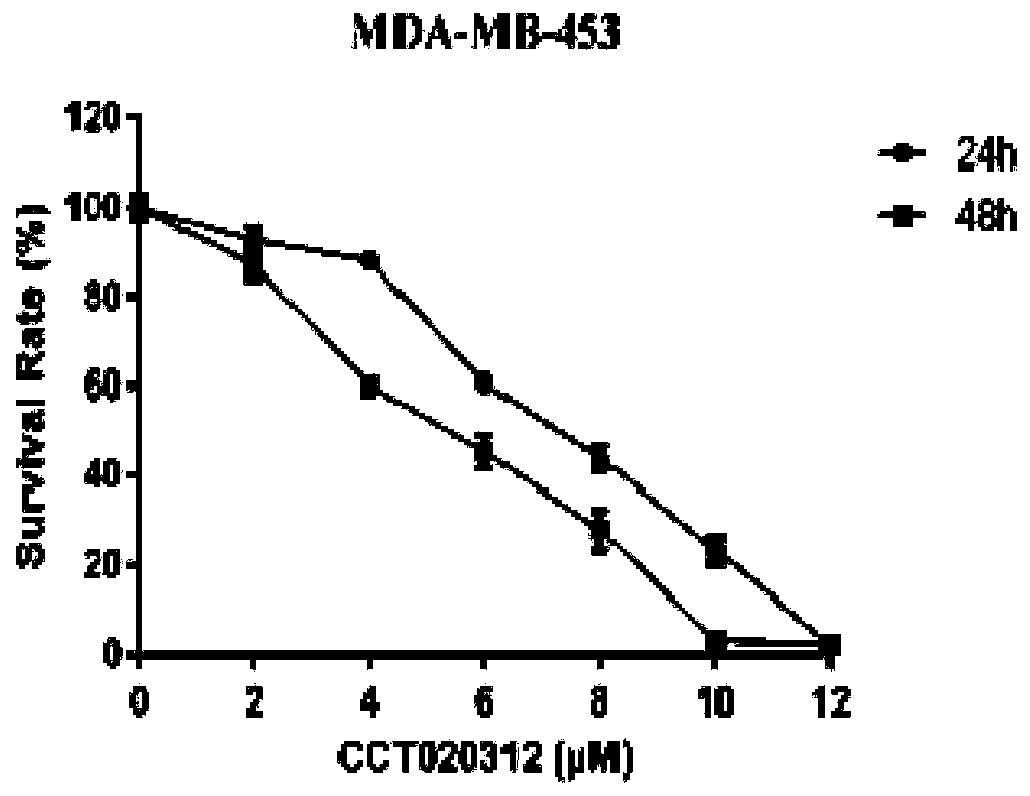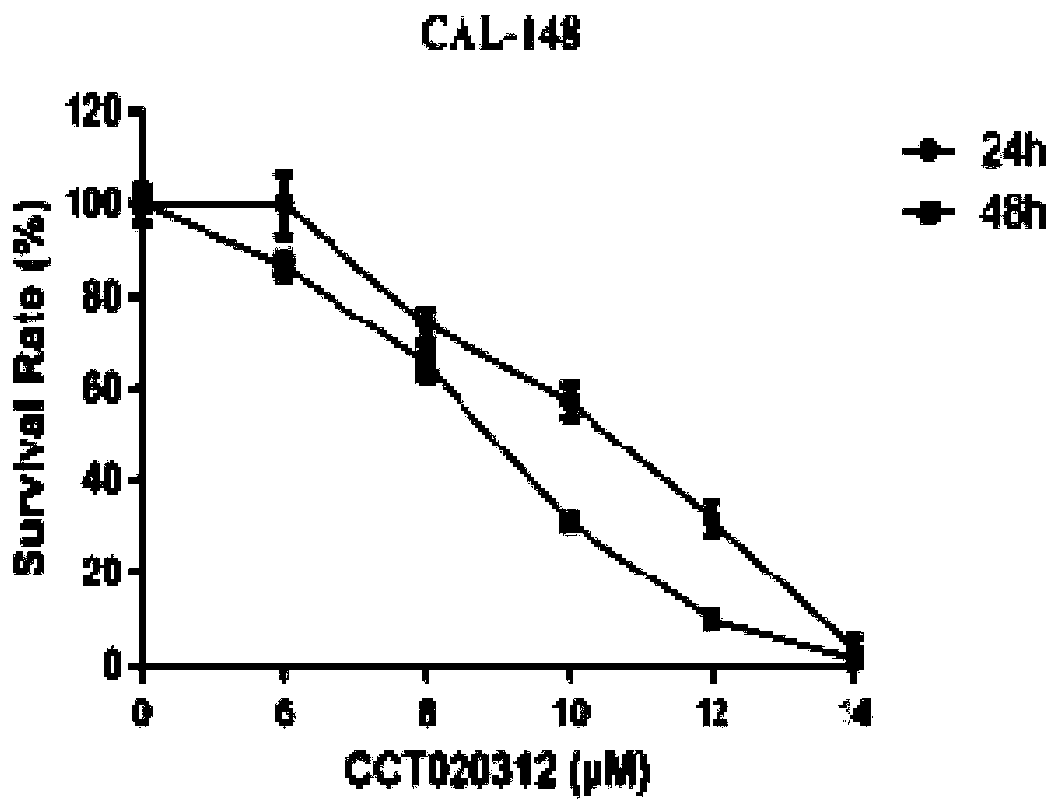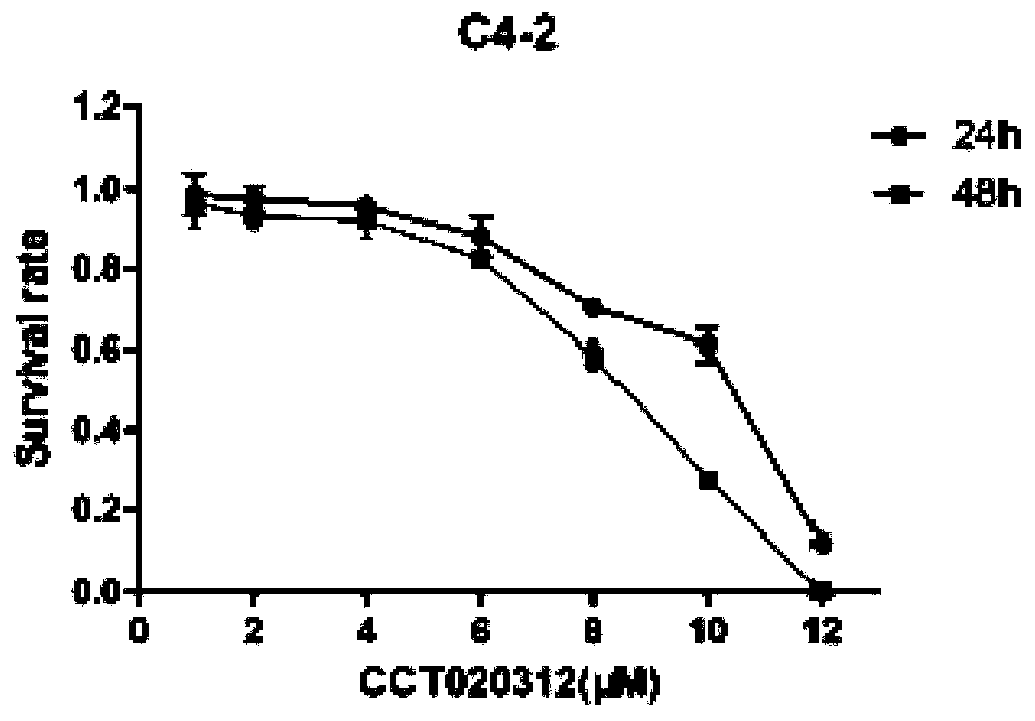Application of cct020312 as medicine for treating breast cancer or prostate cancer
A technology for prostate cancer and breast cancer, applied in the field of biomedicine, can solve the problems of lack of better targeted therapy drugs, large toxic and side effects, drug resistance of patients, and poor prognosis.
- Summary
- Abstract
- Description
- Claims
- Application Information
AI Technical Summary
Problems solved by technology
Method used
Image
Examples
Embodiment 1
[0065] Example 1: CCT020312 inhibits PCa and TNBC cell viability and proliferation
[0066] CCK-8 experiment: Inoculate the cells in a 96-well plate, 180 μl per well, and set up a blank control group and a negative control group. After the cells adhere to the wall overnight, add different concentrations of CCT020312 to treat the cells for 24h or 48h, and discard the supernatant. After adding CCK-8 solution (CCK-8 stock solution: medium = 1:100) and incubating for 1-2 hours, use a microplate reader to detect the OD value of each well at 570 nm. Experimental results such as Figure 1-Figure 4Shown: CCK-8 test results show that after TNBC cells (MDA-MB-453, CAL-148) and PCa cells (LNCaP, C4-2) were treated with CCT020312 for 24h and 48h, the cell viability gradually decreased in a dose-dependent manner. After statistics and calculation: after CCT020312 treated MDA-MB-453 cells for 24 hours, the IC50 of CCT020312 was 7.047 μM; after CCT020312 treated MDA-MB-453 cells for 48 hours...
Embodiment 2
[0069] Example 2: CCT020312 induces PCa and TNBC cell apoptosis, autophagy and G1 phase arrest
[0070] Cell cycle detection by flow cytometry: cells were seeded in 6-well plates, and after adherence, different concentrations of CCT020312 were added to treat for 24 hours. After the cells were digested with trypsin, centrifuged at 1000r / min for 5min, the supernatant was discarded, washed twice with PBS, and centrifuged. Flow cytometric detection was performed after fixing with pre-cooled 70% absolute ethanol overnight. Experimental results such as Figure 11-Figure 14 As shown, CCT020312 can cause the G1 phase arrest of MDA-MB-453 cells and LNCaP cells, thereby affecting the cell cycle and inhibiting the proliferation of cancer cells.
[0071] Cell apoptosis detected by flow cytometry: cells were inoculated in 6-well plates, and treated with different concentrations of CCT020312 for 24 hours after adhering to the wall, after trypsinized cells, centrifuged at 1000r / min for 5min...
Embodiment 3
[0073] Example 3: Effect of CCT020312 on signaling pathways of PCa and TNBC cells
[0074] After using different concentrations of CCT020312 to treat MDA-MB-453 cells and C4-2 cells for 24h (for MDA-MB-453 cells, the drug concentration used was 0 μM, 6 μM, 8 μM and 10 μM; for C4-2 cells, the drug used Concentrations are 0 μM, 8 μM, 10 μM and 12 μM), and then use Western blot to detect the influence of CCT020312 on the signaling pathways of PCa and TNBC cells. The detection process is the same as the Western blot detection in Example 2, except that the detection objects are changed to PERK, p- PERK, ATF4, CHOP, p-eIF2α and eIF2α six PERK / eIF2α / ATF4 / CHOP pathway related proteins. Since prostate cancer and breast cancer are highly correlated with the expression level of androgen receptor (AR), this embodiment also detects the protein expression level of AR. For MDA-MB-453 cells, this experiment example also used 8μMCCT020312 to treat the cells (for MDA-MB-453 cells) for differen...
PUM
 Login to View More
Login to View More Abstract
Description
Claims
Application Information
 Login to View More
Login to View More - R&D
- Intellectual Property
- Life Sciences
- Materials
- Tech Scout
- Unparalleled Data Quality
- Higher Quality Content
- 60% Fewer Hallucinations
Browse by: Latest US Patents, China's latest patents, Technical Efficacy Thesaurus, Application Domain, Technology Topic, Popular Technical Reports.
© 2025 PatSnap. All rights reserved.Legal|Privacy policy|Modern Slavery Act Transparency Statement|Sitemap|About US| Contact US: help@patsnap.com



